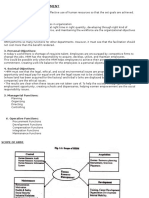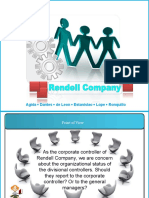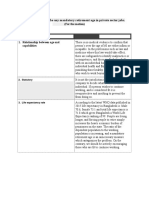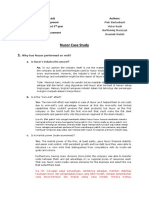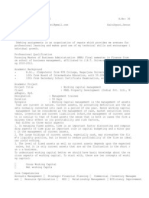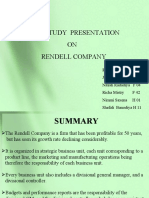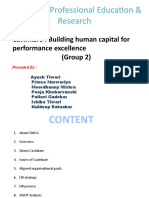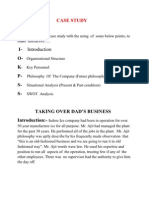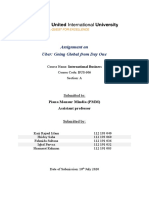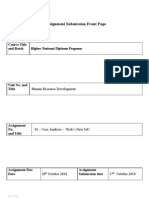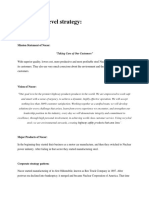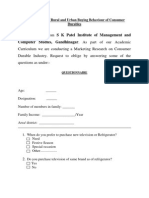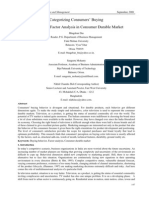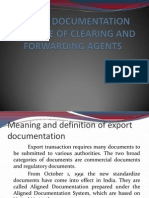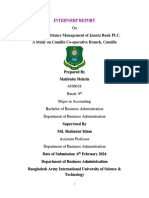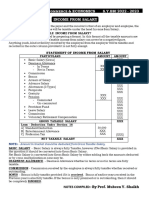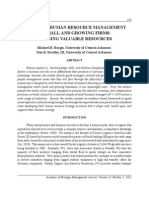Mcs Nucor Case
Mcs Nucor Case
Uploaded by
Shukla JineshCopyright:
Available Formats
Mcs Nucor Case
Mcs Nucor Case
Uploaded by
Shukla JineshCopyright
Available Formats
Share this document
Did you find this document useful?
Is this content inappropriate?
Copyright:
Available Formats
Mcs Nucor Case
Mcs Nucor Case
Uploaded by
Shukla JineshCopyright:
Available Formats
Summary Nucor is an industrial steel company headquartered in Charlotte, North Carolina.
They are an innovative and lean company operating with safety in mind and a goal of returning investments to stockholders. There management system is extremely lean and consist of 5 levels. Nucor is a highly segmented and independent company. They benefit from each manager operating there segment as its own business entity. This prospective allows Nucor to maintain a high degree of entrepreneurship throughout its vast corporation. Nucor maintains a high level of respect between management and its employees. This relationship has allowed management to achieve success through financial goals and has given employees job security and a great working environment. Nucor has essentially eliminated the barrier between management and employee. The employees have the exact same benefits as management. Management has also taken on not buy corporate jets, cars, and country club memberships like other big time companies do. Nucor has also pioneered the mini-mill steel factory allowing for them to cut operating costs compared to traditionally steel factories. This mill has also led to reduction in energy use and pollution. Environmentally speaking Nucor has continued to be an industry best. Nucor recycles 1 ton of steel for every two seconds making it the largest recycler of any material in America-more than the nation's entire aluminum can industry.
Questions 1. Why has Nucor performed so well? a. Is Nucor's industry the answer? h. Is it the "mini-mill" effect? c. Is it market power )scale economies)? d. Is it a distribution channel advantage? c. Is it a raw material advantage? f Is it a technology advantage? g. Is it a location advantage? h. Is it the result of an entrenched brand name? i. Is it Nucor's choice of a unique strategy? j. Is it Nucor's ability to execute its strategy? Nucors focuses on 2 major competencies i.e. building steel manufacturing facilities economically and operating them productively. The companys hallmarks were continuous innovation, modern equipment, individualized customer service, and a commitment to producing high quality steel and steel products at competitive prices. The general manager at each plant was granted considerable autonomy, essentially operating the facility as an independent business.
Technology is one of Nucors key strengths because of the amount of resources they can save due to it. They also have plants with low pollution levels. Continuing Innovations allows Nucor to continue to hold its technological edge on the competition. Nucor is an industry leader when it comes to innovation. 2. What are the most important aspects of Nucor's overall approach to organization and control that help explain why this company is so successful? How well do Nucor's organization and control mechanisms fit the company's strategic requirements? Nucor makes Use of modern equipment and produces high quality products at competitive prices. Nucor has a very flat organization structure. Managers are given autonomy at each plant Decisions are made quickly without the need to wait for decisions from headquarters. Plants can source there inputs from other Nucor plants or from the outside market. Its policies towards employees are very innovative and employee friendly. Anyone would like to work for this company. They have Performance based compensation. Another key aspect of Nucors relationship with its workers was its commitment not to lay off employees in periods when business was down. It Promotes good customer service. 3. A crucial element of Nucor's success is its ability to mobilize two types of knowledge: plant construction and start-up know-how: and manufacturing process know-how. What mechanisms does Nucor employ to manage knowledge effectively'? a. What mechanisms help the company accumulate these two types of knowledge in individual plants? b. What mechanisms exist within the company to facilitate sharing this knowledge among its 25 plants'? c. How does Nucor transfer knowledge to a greenfield, start-up operation? Ans: Nucors philosophy was to build or rebuild at least one mill every year, in the latter case rebuilding entirely rather than just put(ting) new pipes in parts of the old mill. In building new plants or rebuilding existing plants, the company did not rely on outside contractors, but instead handed the responsibility for design and construction management to a small group of engineers selected from existing Nucor fhcilities. For example, when it decided to add a second rolling mill at Nucor-Yamato in Blytheville, Arkansas, it assigned the meltshop supervisor in the first mill to coordinate the design and construction of the meltshop in the second mill. As Greg Mathis, this meltshop supervisor, observed, They put it all on my shouldersthe planning, the engineering, the contracting, the budgets.. .I mean, we are talking about an investment of millions of dollars and I was accountable for all of it. It worked out fine. . . because my team and I knew what not to do from our experience running the meltshop on the first line. Further, the actual construction of the plant was done by workers from the local area, who were aware that they would subsequently be recruited to operate the mills as well.
It lets the employees invest in technology. People in mills identify and select most of the technology. 4. Nucor repeatedly has demonstrated the ability to be a successful first mover in the adoption of new technology. How does the company's approach to organization and control contribute to this first-mover advantage? This is because of the companys tolerance for experimentation and willingness to take risks. Nucor did not have a formal R&D department, a corporate engineering group, or a chief technology officer. Instead, it relied on equipment suppliers and other companies to do the R&D, and they adopted the technological advancements they developed--whether in steel or iron making, or in fabrication. Integrated steel companies produced steel from iron ore using blast furnaces. Nucor successfully adopted the "mini-mill" concept--first developed in Europe and Japan--in the plant it built in Darlington, South Carolina. Unlike integrated steel companies, mini-mills did not start with iron ore: instead, they converted scrap steel into finished steel using small-scale electric furnaces. Nucor purchased its scrap requirements from third-party agents at open market prices. At its Crawfordsville facility, Nucor gambled on the thin-slab casting technology developed by SMS Schloemann-Siemag, a West German company. Staff engineers from more than 100 steel companies visited SMS to explore this technology, which had been demonstrated in a small pilot but not yet proven commercially. But Nucor adopted the process first, obtaining the rights from SMS by signing a nonexclusive contract with an additional technology flow- back clause. Nucor's investment in the Crawfordsville plant represented approximately five times the company's 1987 net earnings and virtually equaled the stockholders' total equity in the company that year. By 1997 Nucor had built two more mini-mills (in Hickman, Arkansas, and Charleston, South Carolina), both using the thin-slab casting process to produce flat-rolled sheet steel. The first competitive facility to make thin-slab-cast flat-rolled steel did not appear until 1995--eight years after Nucor's pioneering effort.
5. Would you like to work for Nucor? Yes. Because Nucor takes an egalitarian approach towards employee benefits. Employee relations at Nucor were based on four principles: 1. Employees will have the opportunity to earn according to their productivity. 2. Employees should feel confident that if they do their jobs properly, they will have a job tomorrow job security, reduce work week instead of fire or lay off employees. 3. Employees have the right to be treated fairly 4. Employees must have an avenue of appeal when they believe they are being treated unfairly grievance process
6. Why have competitors not been able to imitate Nucor's performance so far? Ans: Competitive advantage almost never grows out of a single activity. Unique products or services are often easily imitated by competitors. True sustainable advantage comes from systems of activities that are complementary. As such, competitors no longer have to match just one thing, but rather a whole system if they wish to enjoy many of the same benefits. Companies with sustainable competitive advantage integrate lots of activities within the business, all of which are consistent, interconnected and mutually reinforcing. Interaction, or fit, also redoubles the imitation-deterring effects of imitation costs, limits on managerial capacity, and casual ambiguity.
You might also like
- MCOM Assignment - Shubham Goldiee Masala - DhaneeshDocument4 pagesMCOM Assignment - Shubham Goldiee Masala - DhaneeshDHANEESH KNo ratings yet
- Case Study On ITDocument8 pagesCase Study On ITDHARSHNI P GRGSMSNo ratings yet
- Human Resource Management BBA 4th Sem All Units NotesDocument119 pagesHuman Resource Management BBA 4th Sem All Units NotesAnonymous 03qvZqP84% (45)
- New Jersey InsuranceDocument2 pagesNew Jersey Insurancerksp9999950% (2)
- Case Study - Management Control - Rendell CompanyDocument17 pagesCase Study - Management Control - Rendell CompanyJed Estanislao60% (5)
- Case JBC in India DraftDocument4 pagesCase JBC in India DraftTuan Lien100% (1)
- Apple Stock BuybackDocument2 pagesApple Stock BuybackalimithaNo ratings yet
- Case 9 1Document2 pagesCase 9 1Jessica Tjan80% (5)
- AMG&Forsythe CaseDocument14 pagesAMG&Forsythe CaseSaumitra NandaNo ratings yet
- 20 Roles and Responsibilities of HR ManagerDocument6 pages20 Roles and Responsibilities of HR ManagerAyushi Dhingra100% (3)
- Case Analysis American University of Beirut Medical Centre (AUBMC) PACADI FrameworkDocument7 pagesCase Analysis American University of Beirut Medical Centre (AUBMC) PACADI FrameworkAdarsh Nayan100% (1)
- Nucor Case Study AnalysisDocument3 pagesNucor Case Study AnalysisFaizan MakhdoomNo ratings yet
- Pom Asychronous 2Document1 pagePom Asychronous 2B V Avinash Chowdary 2027931No ratings yet
- Nucor PresentationDocument36 pagesNucor Presentationdrankitamayekar100% (1)
- Assignment 5-2020Document2 pagesAssignment 5-2020Muhammad Hamza0% (4)
- Solution For Vegetron Case StudyDocument11 pagesSolution For Vegetron Case StudyMonika KauraNo ratings yet
- Hindalco'S Acquisition of Novelis: The Making of A GiantDocument11 pagesHindalco'S Acquisition of Novelis: The Making of A GiantHarshShahNo ratings yet
- FM - Assignment Batch 19 - 21 IMS IndoreDocument3 pagesFM - Assignment Batch 19 - 21 IMS IndoreaskjdfaNo ratings yet
- Tips For The Emerson Electric CaseDocument3 pagesTips For The Emerson Electric CaseCahyo Priyatno0% (1)
- Design Thesis On Smart Modular KitchenDocument105 pagesDesign Thesis On Smart Modular KitchenVishal Thakur94% (34)
- Henry FordDocument14 pagesHenry FordIsaiah Ogutu100% (1)
- Private Sector Retirement (Bangladesh)Document4 pagesPrivate Sector Retirement (Bangladesh)sarahNo ratings yet
- Nucor Case Study Solution Performance MeasurementDocument9 pagesNucor Case Study Solution Performance MeasurementDickyWahyuChandraNo ratings yet
- Assignment - Vishal EngineeringDocument2 pagesAssignment - Vishal EngineeringAnish Pillai100% (1)
- Nucor (MCS)Document37 pagesNucor (MCS)Gaurav Yadnik0% (1)
- ResumeDocument2 pagesResumeViswanath TurlapatiNo ratings yet
- Case 1 XeroxDocument4 pagesCase 1 Xeroxalanz123No ratings yet
- CASE 2 Suburban Electronics Company Session17Document7 pagesCASE 2 Suburban Electronics Company Session17Hilmi DaffaNo ratings yet
- Narayana Health: The Initial Ipo DecisionDocument9 pagesNarayana Health: The Initial Ipo DecisionKANVI KAUSHIKNo ratings yet
- What Is The Significance of "Conflict Zones" in Emerging Economies, Especially From The Viewpoint of MNCS?Document4 pagesWhat Is The Significance of "Conflict Zones" in Emerging Economies, Especially From The Viewpoint of MNCS?Akshada VinchurkarNo ratings yet
- Whiz Calculator CompanyDocument18 pagesWhiz Calculator CompanyAsibur Rahman100% (1)
- Xerox Case StudyDocument19 pagesXerox Case StudyPrachi Jain100% (2)
- Ambuja - Holcim (Gaurav)Document18 pagesAmbuja - Holcim (Gaurav)Gaurav AgrawalNo ratings yet
- Case Study On Solartronics, IncDocument3 pagesCase Study On Solartronics, IncSrishti Wadhwa100% (2)
- Grizzly Bear LodgeDocument4 pagesGrizzly Bear LodgeTanya KingNo ratings yet
- Merger of ICICI Bank With ICICI LTDDocument13 pagesMerger of ICICI Bank With ICICI LTDAlphonsa Joseph0% (1)
- F08120000220104013F0812 P13 Emerging Issues in Accounting and AuditingDocument21 pagesF08120000220104013F0812 P13 Emerging Issues in Accounting and AuditingTFI Student Community0% (1)
- Case Study 2Document5 pagesCase Study 2what_the_fukNo ratings yet
- Motilal Oswal Financial Services LTDDocument8 pagesMotilal Oswal Financial Services LTDKshitij SharmaNo ratings yet
- Case Study Presentation ON Rendell Company: Presented ByDocument14 pagesCase Study Presentation ON Rendell Company: Presented Bynimmisaxena2005No ratings yet
- Market Structure of Indian IT Industry-InFOSYSDocument20 pagesMarket Structure of Indian IT Industry-InFOSYSNitin ChidarNo ratings yet
- Jane Belinda Saranga - CASE 1-3 Xerox CorporationDocument2 pagesJane Belinda Saranga - CASE 1-3 Xerox CorporationJane Belinda SarangaNo ratings yet
- Walmart Finance and Strategy E3 InternshipDocument3 pagesWalmart Finance and Strategy E3 InternshipBrandonNo ratings yet
- No.2 FA Assignment 3 Amato FIXDocument3 pagesNo.2 FA Assignment 3 Amato FIXKevin DeswandaNo ratings yet
- Cash Flows IIDocument16 pagesCash Flows IIChristian EstebanNo ratings yet
- Dabur India-CorporateGovernance ReportDocument24 pagesDabur India-CorporateGovernance ReportRomesh Angom100% (1)
- Cavinkare: Building Human Capital For Performance Excellence (Group 2)Document11 pagesCavinkare: Building Human Capital For Performance Excellence (Group 2)Prince NarwariyaNo ratings yet
- FOM Case StudyDocument4 pagesFOM Case Studyfreaky_kunal007No ratings yet
- Draft For Phone RevisionsDocument10 pagesDraft For Phone RevisionsHualu Zhao100% (1)
- CF Final (1) On PTR Restaurant Mini CaseDocument23 pagesCF Final (1) On PTR Restaurant Mini Caseshiv029No ratings yet
- The Investment Detective (Answer)Document2 pagesThe Investment Detective (Answer)Eddy ErmanNo ratings yet
- 1321612987financial AnalysisDocument15 pages1321612987financial AnalysisMuhammad Arslan UsmanNo ratings yet
- Assignment On Uber: Going Global From Day One: Course Name: International Business Course Code: BUS 606 Section: ADocument5 pagesAssignment On Uber: Going Global From Day One: Course Name: International Business Course Code: BUS 606 Section: AIqbal JoyNo ratings yet
- Merger & Acquisition of ICICI With ICICI BankDocument11 pagesMerger & Acquisition of ICICI With ICICI BankAbhishek RathodNo ratings yet
- Assignment Submission Front Page: Higher National Diploma ProgramDocument6 pagesAssignment Submission Front Page: Higher National Diploma Programjuzzy52100% (1)
- Central Equipment CompanyDocument6 pagesCentral Equipment CompanySiddhanth MunjalNo ratings yet
- Case 2Document5 pagesCase 2giscapindy100% (4)
- Hindalco Novelis FINALDocument18 pagesHindalco Novelis FINALanushriNo ratings yet
- Chapter 14Document1 pageChapter 14Rhap SodyNo ratings yet
- SM Sugar Industry Group9Document3 pagesSM Sugar Industry Group9Abhishek Dalal100% (1)
- Case Analysis: Quality Metal Service CenterDocument15 pagesCase Analysis: Quality Metal Service Centerkiran1987100% (1)
- Acc Cement Copy ProjectDocument33 pagesAcc Cement Copy ProjectVrushabh ShelkarNo ratings yet
- NUCORDocument12 pagesNUCORKurniawan Che-uNo ratings yet
- Corporate & Business Level Strategy of NucorDocument3 pagesCorporate & Business Level Strategy of NucorCholo Bristy Namai100% (1)
- Nucor Case Study: University of Łódź Faculty of Management Business Management 3 Year Performance Measurement AuthorsDocument5 pagesNucor Case Study: University of Łódź Faculty of Management Business Management 3 Year Performance Measurement AuthorsGiNo ratings yet
- A Comparison of Rural and Urban Buying Behaviour of Consumer Durables QuestionnaireDocument3 pagesA Comparison of Rural and Urban Buying Behaviour of Consumer Durables QuestionnaireShukla JineshNo ratings yet
- SDM 8 & 9Document25 pagesSDM 8 & 9Shukla JineshNo ratings yet
- Business Ethics ProjectDocument33 pagesBusiness Ethics ProjectShukla JineshNo ratings yet
- Deccan ProjectDocument17 pagesDeccan ProjectShukla JineshNo ratings yet
- QuestionnaireDocument2 pagesQuestionnaireShukla JineshNo ratings yet
- Categorizing Consumers' Buying Behavior: A Factor Analysis in Consumer Durable MarketDocument10 pagesCategorizing Consumers' Buying Behavior: A Factor Analysis in Consumer Durable Marketlokeshwar82No ratings yet
- A Comparison of Rural and Urban Buying of Consumer DurablesDocument18 pagesA Comparison of Rural and Urban Buying of Consumer DurablesShukla JineshNo ratings yet
- Questionnaire: Study On Organized and Unorganized Retail Markets in IndiaDocument1 pageQuestionnaire: Study On Organized and Unorganized Retail Markets in IndiaShukla JineshNo ratings yet
- Risk Management in Indian Banks: Some Emerging Issues: Dr. Krishn A.Goyal, Int. Eco. J. Res., 2010 1 (1) 102-109Document8 pagesRisk Management in Indian Banks: Some Emerging Issues: Dr. Krishn A.Goyal, Int. Eco. J. Res., 2010 1 (1) 102-109Shukla JineshNo ratings yet
- Export Documentation and Role of Clearing and ForwardingDocument17 pagesExport Documentation and Role of Clearing and ForwardingShukla JineshNo ratings yet
- Ceneco V Sec Labor 1991 DigestDocument2 pagesCeneco V Sec Labor 1991 DigestMekiNo ratings yet
- Be Final Project - Kimia FarmaDocument34 pagesBe Final Project - Kimia FarmaRayendra RiginNo ratings yet
- Internship ReportDocument61 pagesInternship Reportomijr7458No ratings yet
- FIFA Sustainable Sourcing Code EN - Sept 2021Document12 pagesFIFA Sustainable Sourcing Code EN - Sept 2021Xinyue SONGNo ratings yet
- Role of Bakery To The SocietyDocument8 pagesRole of Bakery To The SocietyMarianne Dawn GabuatNo ratings yet
- 1930586663Document285 pages1930586663Tsengee Bayaraa100% (1)
- Leave W/ Pay Leave W/ Pay Holiday Pay Holiday Pay: Total Deductions Total DeductionsDocument1 pageLeave W/ Pay Leave W/ Pay Holiday Pay Holiday Pay: Total Deductions Total DeductionsVic CumpasNo ratings yet
- Theory On Income From Salary Sybbi 2022 2023 Part 1Document4 pagesTheory On Income From Salary Sybbi 2022 2023 Part 1Rakesh PulishettyNo ratings yet
- 5 Job Skills Checklist Page 1Document2 pages5 Job Skills Checklist Page 1api-253511870No ratings yet
- Human Resource Management 11th Edition Rue Solutions Manual 1Document36 pagesHuman Resource Management 11th Edition Rue Solutions Manual 1victoriahutchinsontzbpmigrcs100% (48)
- Marketing Orientation and Its DeterminantsDocument35 pagesMarketing Orientation and Its DeterminantsktsakasNo ratings yet
- Halogen EAppraisal - Doc 1Document6 pagesHalogen EAppraisal - Doc 1reza0064No ratings yet
- Internship Report On MSC Textile CompanyDocument48 pagesInternship Report On MSC Textile CompanySheikh Saad Bin ZareefNo ratings yet
- Bus 801 PDFDocument310 pagesBus 801 PDF099153432843No ratings yet
- G.R. No. 186621 March 12, 2014 South East International Rattan, Inc. And/Or Estanislao AgbayDocument41 pagesG.R. No. 186621 March 12, 2014 South East International Rattan, Inc. And/Or Estanislao AgbayBrigitte PocsolNo ratings yet
- Strategic Human Resource Management in Small and Growing Firms: Aligning Valuable ResourcesDocument22 pagesStrategic Human Resource Management in Small and Growing Firms: Aligning Valuable ResourcesFadzlli AminNo ratings yet
- Driving Growth Through Strategic Workforce Planning: Wipro Consulting ServicesDocument7 pagesDriving Growth Through Strategic Workforce Planning: Wipro Consulting ServicesVinay ArtwaniNo ratings yet
- OCE Referral Regarding Ms. Cynthia Martin. Rev. No. 16 1190 Referral 2-8-2017Document9 pagesOCE Referral Regarding Ms. Cynthia Martin. Rev. No. 16 1190 Referral 2-8-2017Beverly TranNo ratings yet
- Case Digest On Maritime Law ConceptsDocument10 pagesCase Digest On Maritime Law ConceptsJohn Baja GapolNo ratings yet
- Employee Empowerment and Its Effect On Organizational PerformanceDocument5 pagesEmployee Empowerment and Its Effect On Organizational PerformanceAlejandro Montano CorreaNo ratings yet
- CoronavirusDocument2 pagesCoronavirusianachieviciNo ratings yet
- Ally Dunhill Barbara Elliott Angela Shaw Effective Communication and Engagement With Children and Young People Their Families and Carers Creating Integrated Services Learning Matters 2009 1 PDFDocument136 pagesAlly Dunhill Barbara Elliott Angela Shaw Effective Communication and Engagement With Children and Young People Their Families and Carers Creating Integrated Services Learning Matters 2009 1 PDFAdelaida PopaNo ratings yet
- 3.TN Pension RulesDocument397 pages3.TN Pension RulesPorkodi Sengodan50% (2)
- CCDC3Document3 pagesCCDC3sheriffkuteyi308No ratings yet
- Eureka ForbesDocument40 pagesEureka ForbesSrinath chinnaNo ratings yet
- 26.romulo Mabanta v. Home Development Mutual FundDocument8 pages26.romulo Mabanta v. Home Development Mutual FundSeonoNo ratings yet


